Understanding Bird Cage Parts: A Guide for Enthusiasts
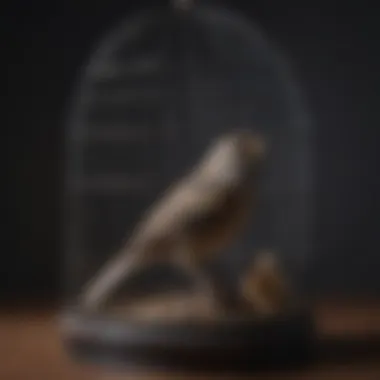
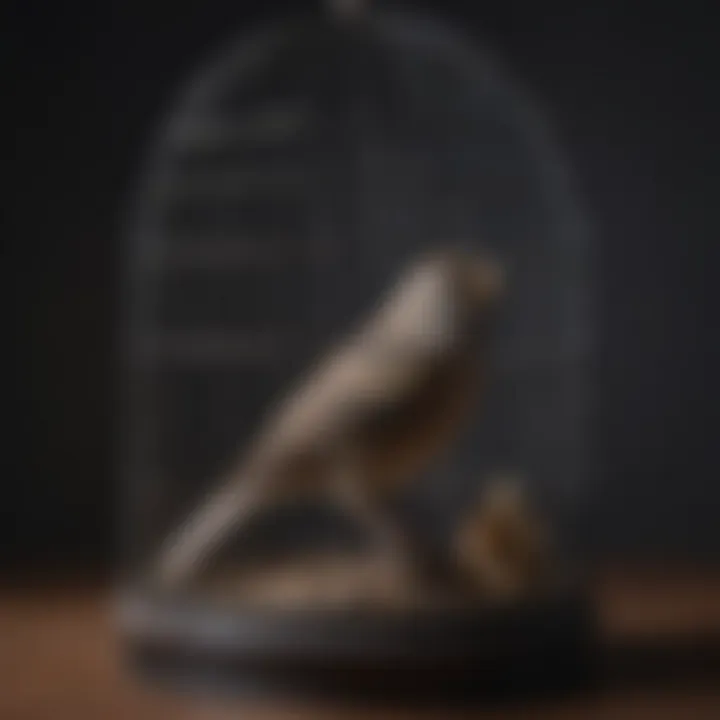
Intro
Pet birds require specialized living conditions to thrive, and a crucial element in providing a suitable environment is the bird cage. This guide focuses on the various parts of cages and their significance in maintaining a healthy and fulfilling habitat for birds. Knowing how each component contributes to a bird’s overall well-being can empower owners to make informed choices.
A bird cage is not merely a container; each piece serves a unique purpose. These components include the frame, bars, base, accessories, and much more. Understanding their specific functionalities is essential for all bird owners, especially since the needs of these friendly creatures can vary significantly. Whether considering size, material, or the layout of the cage, every decision counts. This article breaks down critical insights for designing an ideal habitat tailored to the unique requirements of specific bird species.
Care Tips
Daily Care Routines
Creating a balanced daily schedule is central to your bird’s long-term happiness. Engaging with your bird daily not only builds trust but also ensures that their basic needs are met. Spend time daily observing their behaviors, providing fresh food, and offering clean water.
Cage Setup and Maintenance
Setting up a bird cage should be well thought out. Arrange the cage to provide substantial vertical and horizontal space. Avoid overcrowding; too many toys or perches can cause tension. Maintain appropriate spacing between bars, particularly for smaller birds, as wider gaps could invite escapes or predatory threats.
Hygiene and Cleaning Practices
Frequent cleaning retains a healthy environment, preventing germs buildup. Clean droppings and uneaten food daily, and perform deep cleans weekly. Use warm, soapy water, avoiding harsh chemicals to protect your bird’s sensitive respiratory system.
Seasonal Care Adjustments
Changes in temperature and humidity call for adapting your approach to bird care. Make adjustments to perches and heating sources in colder months. Knowing when to amend food offerings based on season can also boost your bird’s health, such as providing additional hydration during warm weather.
Behavioral Insights
Understanding Bird Body Language
Being skilled in reading your bird’s body language is key to recognizing emotions. Movements such as flapping wings or puffing feathers signal different moods ranging from excitement to distress.
Common Behavioral Issues and Solutions
Recognizing signs of common issues, like excessive screeching or feather plucking, can pave the way for timely intervention. For example, provide forms of stimulation to redirect negative behaviors, such as interactive toys.
Positive Reinforcement Techniques
Encouraging good behavior through positive reinforcement fosters emotional connection. When a pet bird exhibits desired behaviors, rewards like treats will reinforce that continuation and strengthen their bond with the owner.
Social Interaction Needs
Interactions with their owners help birds avoid loneliness. Regular social time reduces stress and helps them feel more secure. Consider designated playtime out of the cage as a means to promote engagement and improve relationship quality.
Nutrition Guides
Essential Diet Components
Providing a balanced diet is crucial for any bird species. A base of high-quality pellets, complemented by fresh vegetables and seeds, serves as fundamental diet ingredients. Research your specific bird’s needs to ensure you offer an appropriate variety.
Safe and Toxic Foods
Crafting a safe diet requires knowledge about edible and non-edible substances. Common safe foods include carrots, apples, and leafy greens, while avocado and chocolate remain toxic and must be avoided entirely.
Supplements and Treats
Occasional treats can add joy to a bird’s routine. Nutritional supplements should be considered for enhanced well-being but should not replace a balanced diet.
Feeding Strategies for Different Species
Adjust feeding approaches depending on the type of bird. Some species prefer varied challenges in obtaining food, like puzzle feeders that keep the feeding process engaging.
Wellness and Health
Routine Health Checkups
Regular veterinary checkups play an essential role in preventing potential health problems. Find an avian veterinarian who can thoroughly assess your bird's health during checkups to address issues before they escalate.
Identifying Symptoms of Illness
Birds can be skilled at hiding discomfort. Observing behavioral changes, poor feather condition, or altered droppings can assist in identifying health problems
Preventative Care and Vaccinations
Understanding necessary vaccinations should guide a bird owners practices for their pet’s preventative health care. Adequate preventive measures avert many severe health concerns.
Mental and Emotional Well-being
A holistic approach toward pet bird health encapsulates both their physical and emotional needs. Ensuring a satisfying environment fosters pets' psychological comfort and happiness.
Enriching Activities
Toys and Playtime Ideas
Ideas for toys should involve different textures, movements, and sounds to pique interests. Integrating swings and ladders enrich the environment, enriching play.
Training and Tricks
Believable training routines strengthen owner's relationship. Simple tricks can cater to a bird's penchant for learning and engaging with owners, enhancing stimulation.
Outdoor Activities and Interaction
Safe outdoor environments provide fresh air and new sights. Supervised outdoor time can add excitement to their routine but must be approached with caution.
DIY Projects for Mental Stimulation
Creating your own toys not only saves costs but ensures engagement for your bird. Develop projects with safe materials suited for your feathered friend.
In summary, maintaining a thriving environment for pet birds requires attentiveness to their physical, emotional, and psychological requirements. By understanding each component of the bird cage and integrating them into regular care routines, owners can ensure happier and healthier companions.
Preface to Bird Cages
Maintaining a healthy and vibrant presence for pet birds is paramount. The selection of a suitable cage is one vital step that encompasses several factors to ensure the well-being of these avian companions. Adequate housing influences not only the health of the bird but also its behavioral patterns. Nesting and resting areas should provide a safe and comforting environment.
The importance of suitable housing cannot be underestimated. Proper housing offers birds space to move, exercise, and thrive. Additionally, the right cage contributes significantly to easy maintenance by its design, allowing owners to keep the environment clean and hygienic for their pets. Analyzing individual characteristics of different bird species can help create a customized living habitat that engages and cultivates proper welfare.
The Importance of Suitable Housing
Suitable housing for birds provides the foundation for their overall health and happiness. A well-chosen cage should meet several criteria, including adequate space, proper design, and material suitability. Different species of birds have unique requirements, and failing to meet these can result in stress or health problems.
- Space is a significant consideration. Birds need room to stretch their wings, move about, and have separate areas for different activities.
- Another aspect is the environmental enrichment provided within the cage. Toys, perches, and acceptable materials can stimulate their brains and support proper mental health.
Suitable housing not only mitigates health concerns but also nurtures social behaviors.
Overview of Cage Types
Bird cages come in various forms, each designed for specific needs and considerations. Understanding the basic types of bird cages helps owners choose the best option for their feathered friends. Here are a few noteworthy perspectives:
- Aviary Cages: These are larger and allow birds to fly more freely. They're suitable for keeping multiple birds and promoting healthy social interactions.
- Play Cages: Aimed for short-term use and interaction, offering toys and climbing structures make them very engaging.
- Transport Cages: Used for moving birds, these should prioritize safety and comfort.
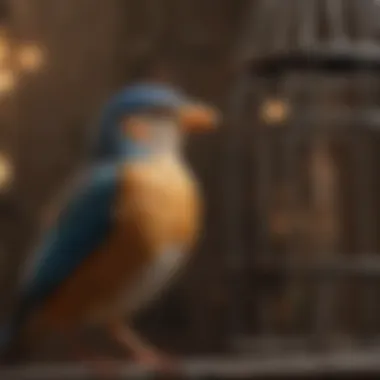
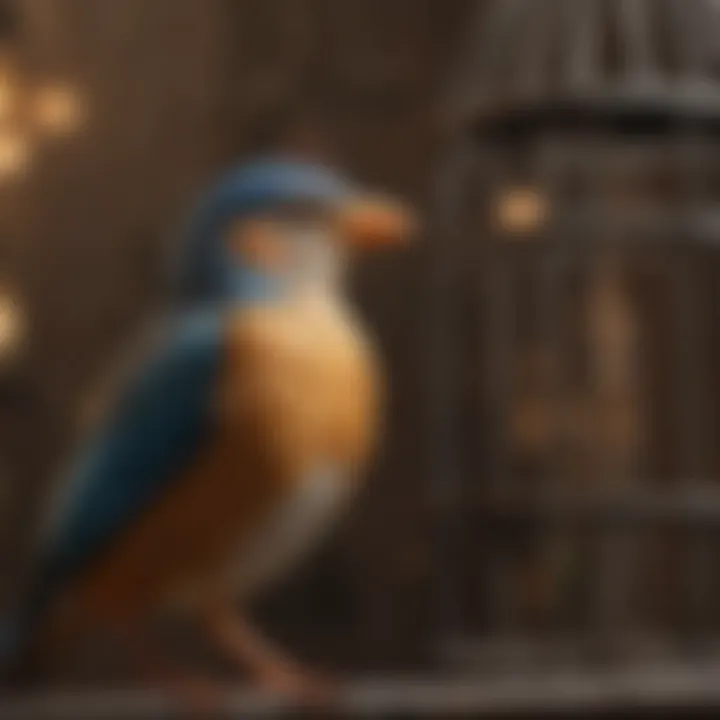
With a range of materials and designs available today, selecting the right cage according to personal preferences and your bird's requirements can lead to improved quality of life. Properly structured cages lead to a conducive environment promoting health, activity, and happiness daily.
Cage Frame and Structure
A bird cage is not just a mere enclosure. It serves as a sanctuary or habitat for the avian companions that inhabit it. The frame and structure of a cage are critical to ensuring the security and well-being of pet birds. A robust, well-designed cage frame combines durability and functionality, allowing for a safe environment. The contribution of the cage frame extends to comfort and cleanliness—key aspects in avian care. Poorly designed cages can result in injuries or undue stress for the birds.
Materials Used in Construction
When it comes to constructing a bird cage, the choice of materials plays a significant role. Different materials come with specific characteristics that can greatly impact the quality and longevity of the cage.
Metal
Metal is a dominant choice in bird cage construction. One pivotal aspect of metal cages is resilience. Metal cages offer strength and durability, making them harder for birds to damage or escape from. A highly favorable characteristic of metal is its ability to resist corrosion; for example, stainless steel resists rust effectively, adding an additional layer of durability. Another advantage is that metal can be easily cleaned and disinfected, which is vital for maintaining hygiene. However, one must consider potential negative factors, such as sharp edges. It is essential to ensure bars and openings are perfectly rounded to prevent injuries.
Wood
Wood has its own merits when used in building bird cages. This option is known for its natural aesthetics, appealing to bird owners who prefer a rustic look. Wooden cages can provide better insulation, helping to keep the habitation cozy for birds in colder climates. Moreover, avian species often find wood attractive, and it may invite climbing or chewing behavior that is instinctive in many birds. Despite these positives, wood can be prone to moisture damage and may attract pests, so careful treatment and maintenance are necessary.
Plastic
Lastly, plastic is also a common material for bird cages, particularly for lightweight variants. Its most notable benefit lies in ease of cleaning, as plastic surfaces do not rust or corrode. This material is often less expensive and can be produced in various colors and designs, which can add a playful touch to a bird's environment. However, due to its lighter composition, plastic cages may not be suitable for larger bird species, as they might be less stable when climbing.
Design and Safety Considerations
Safety is paramount in selecting a bird cage. Considerations such as spacing of bars must be suited for the bird species. Likewise, round bars are less likely to injure birds, as sharp edges can lead to various injuries. Finally, ensuring there are no toxic paints or materials is critical to avoid health hazards.
In summary, the choice of materials affects not only the aesthetics of the cage but also its safety and functionality. As an avian enthusiast, knowledge about these components will help in selecting a cage that promotes a healthy habitat for your feathered friends.
Cage Bars and Spacing
Cage bars and spacing are vital components of bird cages, directly impacting both the safety and comfort of the pet birds within. The bars provide structure, security, and an interface through which birds interact with their environment. It's essential that these bars not only prevent escapes but also protect birds from injuries caused by improper spacing or inadequate strength.
Bar Thickness and Strength
When considering cage bars, thickness and strength are of great importance. If the bars are too thin, they may bend or break under pressure. This can be a significant risk, particularly with larger or stronger bird species. Most cages on the market range from two to four millimeters in thickness. While a thinner bar may be less costly, it sacrifices durability.
A strong cage frame benefits even smaller breeds. Birds are curious creatures, and they often try to push or weaken structures in their environment. Sturdy bars help prevent dangerous situations. Typically, metals such as stainless steel and wrought iron demonstrate excellent strength properties and are widely used in bird cage construction.
Ideal Bar Spacing for Different Species
Bar spacing can greatly vary depending on the species of bird. Incorrect spacing could either allow smaller birds to escape or leave gaps large enough for a head or foot to become trapped, causing injury or even death. Generally,
- For smaller birds like finches or budgerigars, a spacing of around 1/2 inch is deemed suitable.
- Medium-sized birds such as cockatiels require spacing of about 3/4 inch.
- Larger birds, including African greys and macaws, need spacing closer to 1 inch to prevent dangerous encounters.
Wild birds in their natural habitat have learned to navigate through varied dimensions. It’s crucial to mimic these conditions as closely as safe housing allows. Always verify measurements based on the specific requirements of the bird species you own. This practice keeps owners avert damage and promotes a safer and happier environment for your avian pets.
Properly measured bars and spacing can lead to longer, healthier lives for your feathered friends.
In summary, cage bars and spacing not only provide security but also define the quality of life for your birds. A cage designed with the right materials and measurements offers essential support for the well-being of your avian companions.
Cage Bottom and Tray
The bottom of a bird cage serves as a crucial element in creating a safe and healthy environment for pet birds. While many may overlook this area, it plays a significant role in the overall welfare of the birds. The bottom and tray not only collect waste but also provide a stable base for other essential components, making it vital to understand its materials and maintenance aspects.
Materials for the Bottom Tray
Different manufacturers use a variety of materials for the bottom tray of bird cages. Common options include metal, plastic, and sometimes wood. Each material has its pros and cons.
- Metal: This material is durable and often quite easy to clean. Some birds might chew on metal, but select metals pose no health risk, ensuring a long-lasting solution.
- Plastic: Often chosen for its affordability, plastic trays come in vibrating colors, which can brighten the cage environment. However, lower-quality plastic can scratch easily, allowing bacteria to flourish.
- Wood: While giving a natural feel, wooden trays can absorb moisture and moisture if not treated correctly. This might lead to an unhealthy living condition over time.
For avian enthusiasts, consider which material aligns best with your bird's habits and living requirements. Factors such as size, behavior, and even species should influence that choice. Ultimately, the goal is to provide a durable bottom tray that will support the needs of your bird while remaining easy to manage for the owner.
Importance of Easy Cleaning
Cleanliness in a bird cage cannot be overstated. The cage bottom and tray directly contribute to this practice, facilitating the upkeep of the lower environment. Dirty living arrangements can expose your bird to numerous health risks.
Ensuring a clean bottom tray mitigates the spread of bacteria and parasites, vital for your pet's well-being.
A few key reasons for why easy cleaning is essential include:
- Health Benefits: Bacteria and parasites can thrive in unsanitary conditions. A quick-clean tray encourages proper daily maintenance, which consequently reduces the likelihood of illness.
- Aesthetic Appeal: A clean cage helps maintain a visually pleasing habitat. This not only benefits the bird but can be enjoyable for the owner to observe.
- Ease of Access: Trays that are easy to remove and clean reduce stress. Owners can spend more time interacting with their feathered friends rather than dealing with cumbersome maintenance intricacies.
In sum, understanding and appropriately managing the cage bottom and tray creates a harmonious space for your feathery companions. Choosing the right materials and ensuring ease of cleanliness should be a staple in any avian care strategy.
Perches and Platforms
Perches and platforms are significant components within a bird's cage setup. They provide essential spaces for rest, play, and exercise. Offering diverse perching options can prevent boredom and encourage the bird's natural inclination to climb and explore. Variability in perch types helps accommodate the specific physical needs and behaviors of different bird species, ensuring an enriching environment.
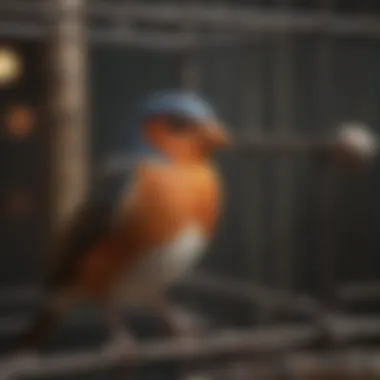
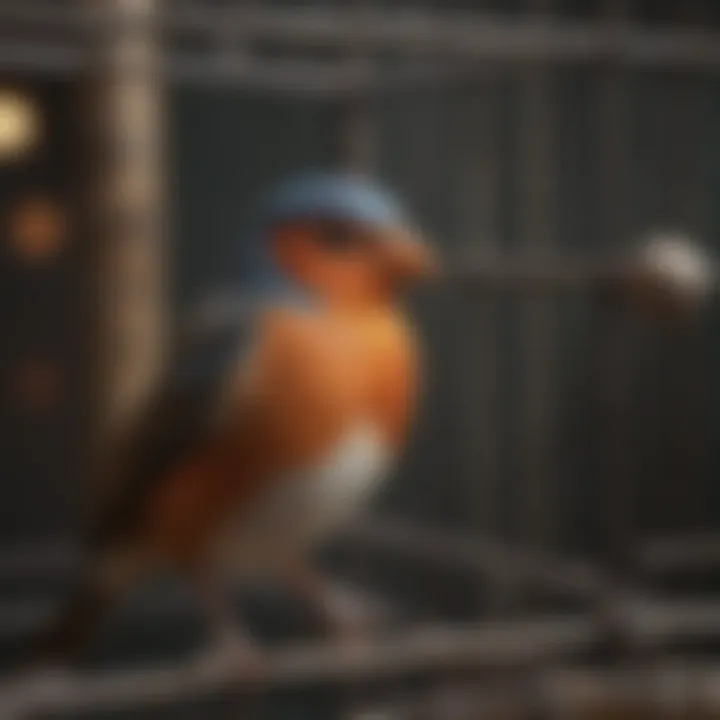
Types of Perches
Natural Wood Perches
Natural wood perches are crafted from untreated, non-toxic branches of various hardwood tree species. Their textured surfaces promote better grip for birds. This characteristic aligns with birds' natural behaviors in the wild. Furthermore, they vary in diameter, helping birds slip into a comfortable standing position. These types foster toe exercise, essential for bird foot health.
While they can be popular choices, maintenance is needed. Regular cleaning is necessary to avoid mold and bacteria. Pros include natural appearances and suitability for gripping workout. However, some woods may splinter, posing injury risks, hence selection is vital.
Sandpaper Perches
Sandpaper perches are often preferred for their gritty surfaces that provide incredible utility. They aid the trimming of nails, helping maintain proper foot health. For species prone to overgrown nails, this type is especially advantageous. The rough texture supports better grip, reducing slips during movement.
Yet, sandpaper can accumulate germs if not cleaned promptly. If grains wear down, this also may affect effectiveness over time. Advantages include maintenance of critical foot health but watch carefully for deterioration over time.
Rope Perches
Rope perches present a flexible solution promoting agility with their adjustable lengths. The natural fiber allows birds to latch securely, enhancing grip and stability. These features encourage birds' natural climbing behavior and activities.
Moreover, they are gentle on a bird's feet, reducing the risk of foot injuries or ailments. However, rope wear and fraying must be monitored. Safety suggests periodic checks to prevent entanglement or loose fiber injury. The flexibility and varied thickness make them favored options for many avian owners; consider this while assessing various setups.
Spacing and Location Strategy
Considering the spacing and location of perches within the cage can truly enhance your bird's living conditions. Proper spacing is advantageous for enabling movement and fostering accessibility.
- Place perches across various heights to recreate elements of their natural habitat. This configuration encourages natural behavior and activity level among birds.
- Ensure bars of the cage provide adequate space between themselves, allowing birds unrestricted freedom of movement.
- Focus on accessibility: consider easy routes between perches for an engaging environment. Various interactions with toys or social engagement:a well-organized cage sustains comfort.
Feeding Stations
Feeding stations are crucial for the health and well-being of pet birds. They provide access to food and hydration, impacting overall health. Properly designed feeding stations help birds maintain an optimal diet and ensure your feathered friends thrive. Important factors include functionality, accessibility, and cleanliness. Failing to ensure these aspects can lead to stress or health issues in birds.
Types of Feeders
Hopper Feeders
Hopper feeders are popular choices for many bird owners. They work by dispensing seed through a small opening, allowing birds to access food without making a mess. One key characteristic of hopper feeders is their ability to hold a larger quantity of seeds, which means less frequent refills. This convenience is beneficial for busy pet owners. However, unless maintained, seeds can become stale or contaminated due to moisture.
Tray Feeders
Tray feeders provide an open space for seed and are easy for several birds to feed together. One notable aspect of tray feeders is their flat design, allowing easy access for all birds. This openness encourages socialization among birds, and it is ideal for species that enjoy foraging. But because they are exposed, the seeds can become dirty quickly. This requires regular cleaning to prevent spoilage.
Water Bottles
Water bottles are essential for ensuring hydration. They maintain a continuous supply of fresh water, which is vital for bird health. The attached nozzle helps to protect the water from contamination. This unique feature allows for long-lasting hydration without requiring frequent water changes. However, some birds may not readily understand how to use water bottles, leading to potential dehydration. It is vital to monitor their usage to ensure every owner provides proper hydration.
Maintaining Cleanliness and Hygiene
Keeping feeding stations clean is fundamental. Dirty feeders and water sources can develop harmful bacteria or mold that affect bird health. Regular cleaning should be done, focusing on the following:
- Remove uneaten food daily to avoid spoilage.
- Clean all components weekly, using bird-safe cleansers.
- Rinse severely before refilling to prevent residue contamination.
Overall, an emphasis on maintaining cleanliness is essential for ensuring your birds are happy and healthy.
Cage Accessories and Enrichment
Cage accessories play a significant role in enhancing the environment for pet birds. Providing a suitable habitat goes beyond ensuring enough space and clean living conditions. Accessories help stimulate cognitive function and promote physical health. This segment focuses on two primary components: toys and aesthetic enhancements, both crucial in aligning with a bird's natural tendencies and behaviors.
Toys and Their Importance
Toys are essential for mental and physical stimulation in birds. Many species, from parrots to finches, require interaction with their environment to keep them engaged. Several types of toys can cater to these needs:
- Chew Toys: Birds love to chew. Providing chew toys can help prevent beak overgrowth while keeping them entertained.
- Interactive Toys: These toys often require birds to solve puzzles or uncover treats, paralleling their foraging instincts. This stimulation is crucial in preventing boredom, which can lead to unintended behaviors like feather plucking.
- Hanging Toys: Birds often enjoy climbing. Hanging toys allow them to exercise their feet and wings.
When selecting toys, consider the bird's size and behavioral tendencies. Safety should always be a priority; avoid toys with small parts that could be ingested or have toxic materials.
Aesthetic Enhancements
Visual appeal in a bird's cage can have its benefits. Aesthetic enhancements, like colorful perches or decorative elements, are not just about looks. For birds, a visually stimulating environment can reduce stress. Incorporating suitable decorations can promote comfort and even encourage exploration. Some considerations include:
- Natural Colors and Patterns: Birds in the wild experience diverse environments. Using natural, earthy colors can create a more welcoming space for captive birds.
- Natural Materials: Consider decorative ropes or climbing materials made from sisal or other natural fibers. This not only adds to the look but also aligns with a bird's instinctual behaviors.
Enrichment does not need to overpower the cage visually. Simplicity is often more beneficial than excessive or intense decoration. Always observe how your bird interacts with these enhancements to provide a tailored experience.
"Birds require not only basic needs but also mental and physical interactions through accessories that mimic their natural environments."
Taking the time to provide adequate toys and aesthetic appeal can positively affect a bird's well-being. Engaging their natural instincts with carefully chosen accessories informs a holistic approach to their care.
Lighting and Ventilation
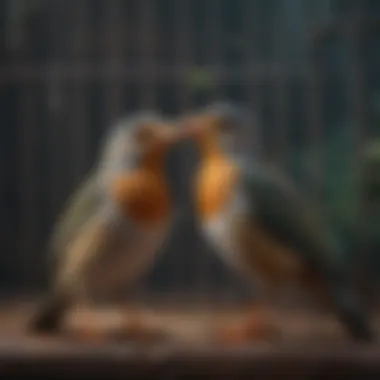
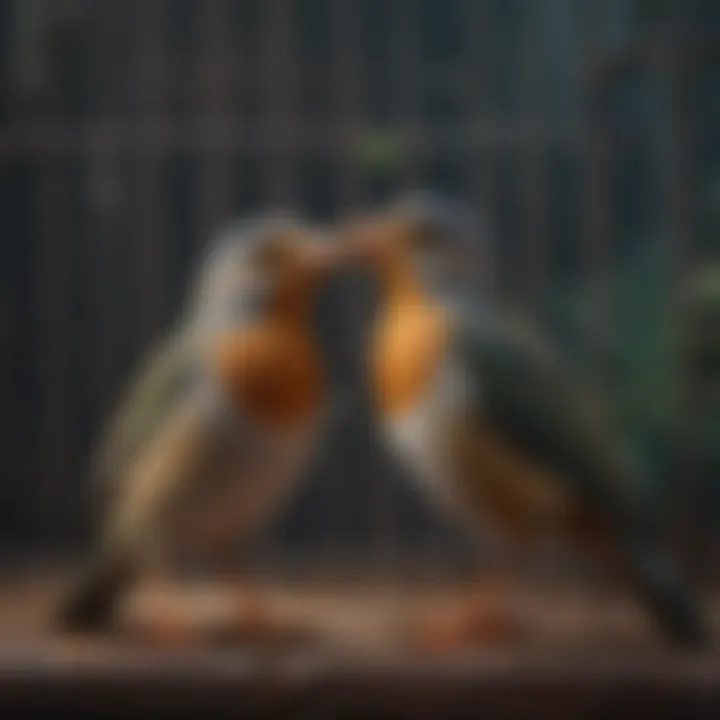
Lighting and ventilation are crucial aspects of creating a suitable habitat for pet birds. Proper light and air circulation can significantly contribute to the birds’ health and overall well-being. In this section, we will delve into the requirements and options for natural and artificial lighting. Additionally, the ventilation system in a bird cage can impact the conditions and comfort of your feathered companion.
Natural Light Requirements
Birds are fundamentally diurnal creatures. This means they rely on natural sunlight to maintain their rhythm and behavior. Exposure to natural light offers numerous benefits. It helps regulate hormonal functions and enhances mood, mimicking their natural environment. The role of sunlight is essential for species that thrive on visual cues for their activities.
When considering natural light exposure, it is necessary to position the cage strategically. Use a location that provides indirect sunlight for several hours daily, ensuring the area is free from drafts. However, make sure to avoid direct sunlight for prolonged periods, as it can lead to overheating and stress.
Factors to determine when organizing natural light access include:
- Duration: Aim for about 12 hours of light showing up daily.
- Time of Day: Mornings and late afternoons provide softer lighting, beneficial for your birds.
- Seasonal Changes: Pay attention to how changing daylight hours during seasons might affect light availability.
Artificial Lighting Options
In situations where natural light options are limited, artificial lighting becomes highly beneficial. This is particularly important during seasons with short days such as winter. Artificial lights can help emulate the benefits of natural sunlight and should be used carefully.
There are several points to reflect upon when opting for artificial lighting:
- Types of Bulbs: Use full-spectrum bulbs specifically designed for birds. Compact fluorescent lights or LED bulbs are known for offering successful alternatives while minimizing heat output.
- Timing Control: Using a timer can help maintain a consistent light schedule, reinforcing the birds' natural rhythms. The routine can be improved with specific rhythms of brightness and dimness.
- Placement: Store the lights within a reasonable distance from the cage to enhance even light without causing overheating.
Appropriately-managed lighting+h ventilation systems improve welfare standards for pet birds remarkably!
Before implementing the artificial lighting, analyses factors like intensity and heat production to ensure that your bird stays comfortable. Understanding these lighting principles can lead to a more comprehensive care routine for your avian neighbors.
Choosing the Right Size
Choosing the right size for a bird cage is crucial. It's not just about aesthetics but also significantly affects the well-being of your avian friend. A properly sized cage provides enough room for movement, exercise, and mental stimulation. Every species of bird has unique needs that must be taken into account to provide an appropriate home for them. Understanding both the specific dimensions of the cage and the needs of the bird will lead to a happier, healthier life for your pet.
Determining Appropriate Dimensions
When calculating the dimensions for a bird cage, consider both height and width. Most birds require vertical space to fly, while horizontal space allows for more room to explore. Below are some considerations to determine the humach of dimensions needed:
- Species Size: Larger birds like parrots and macaws need bigger cages than smaller species like finches or canaries. For instance, a cockatiel may thrive in a cage that is at least 24 inches tall and 18 inches wide.
- Type of Activity: Different birds display various activity levels. If your bird is highly active, it may require additional space for movement. For instance, a budgerigar might do fine in a smaller habitat, but it will benefit from a larger one.
- Quantity of Birds: If you plan to house more than one bird, ensure that the cage dimensions allow for adequate environmental separation. Overcrowding can increase stress and deter natural behaviors.
Assessing Bird Size and Behavior
Bird size and behavior are integrated factors when selecting the right cage size. Knowing how your bird behaves will help optimize its environment. Here are few points to consider:
- Flight Patterns: Some species would rather fly than walk. Consider a cage setup that accommodates flight. Smaller birds might dart from perch to perch, requiring smaller area just for freezy movements.
- Resting Preferences: Pay attention to where your bird prefers to rest. Some birds desire elevated perches, which means that you need to factor in height.
- Social Behavior: Birds are social animals and need enough room to interact with each other if housed in pairs or groups. Lack of space can lead to territorial disputes.
Optimal bird cage size should comfortably allow free movement and support natural behaviors for the particular species.
Safety Features of Bird Cages
The safety of avian companions is paramount. When choosing or utilizing a bird cage, several safety features must be taken into account. These elements not only protect the birds from harm but also assure owners that their pets reside in a secure habitat. By understanding these safety features, bird owners can make informed choices, ensuring the well-being of their feathered friends.
Identifying Hazardous Elements
In the construction of bird cages, there are materials and components that may pose risks. Common hazardous elements include toxic metals like lead and zinc. These substances can leach into the birds' environment, potentially leading to serious health issues.
- Paints and Coatings: Many cage manufacturers use paints to enhance the appearance of the cage. However, some paints contain harmful chemicals. It is best to select cages that use safe coatings or are entirely bare metal.
- Welds and Joints: Poorly constructed welds may contain dangerous materials or create sharp edges that can injure birds. Inspecting these areas is important before establishing a habitat.
- Plastic Parts: Many cages have plastic components. Low-quality plastics can become brittle and break, creating sharp pieces that could lead to injury.
Ensuring that a cage is made from non-toxic, durable materials is crucial for reducing hazards in the environment.
Secure Lock Mechanisms
An overlooked but vital aspect of safety is the lock mechanism. Many birds, particularly species known for being clever, can escape if locks are not secure. Here are some critical features:
- Progressive Locks: Utilizing locks that require multiple steps often deters a bird from accidentally opening them.
- Screw-on Mechanisms: These enhance security. The mechanism needs to be resistant to tampering by the bird, making it less likely for them to open during playful antics.
- No Loose Parts: Locks should not have loose items that could be removed. Keeping mechanisms simple in design often adds to their effectiveness.
Always assess your bird's cage for hazards and ensure that it includes robust lock mechanisms.
Closure
The conclusion serves an essential role in summarizing key points discussed throughout the article. It synthesizes the various components of bird cages and clarifies their significance in establishing a conducive environment for pet birds. By reviewing the role of different elements such as cage structure, bar spacing, accessories, and safety features, the conclusion reinforces how each part contributes to the overall wellbeing of the birds.
Selecting the right bird cage is not just about aesthetics. It involves understanding the needs of specific bird species and incorporating the appropriate features. Ignoring these considerations can lead to behavioral issues, health problems, or stress in the avian companions. Thus, this article helps emphasize responsible pet ownership.
In recapping key takeaways, readers should remember not to rush the decision when choosing a bird cage. Every detail matters, from ventilation to the materials used for construction. Ensuring all aspects align with the bird's needs can enhance their quality of life, encourage vibrant health, and bring them comfort in their living space.
Recap of Key Points
- Importance of Suitable Housing: A suitable cage ensures the comfort and safety of birds.
- Cage Structure: Material choice affects durability and safety.
- Bar Specifications: Bar thickness and spacing are critical to preventing escapes and injuries.
- Cage Cleaning: A functional tray is vital for hygiene and routine maintenance.
- Feeding Stations: Different types of feeders cater to individual feeding behaviors and habits.
- Lighting and Ventilation: Natural light sources enhance well-being.
- Safety Features: Proper locks and avoiding harmful materials protect birds from dangers.
Final Thoughts on Bird Cage Selection
Cage selection should always prioritize the birds' sectors needs. For an ideal choice, owners must consider not just size and aesthetics, but also functionality and safety. When comparing options, take time in evaluating dimensions alongside species-specific behavior.
Researching brands with a proven track record of producing bird-safe products is essential. Products like the Prevue Hendryx Bird Cage or the Vision Bird Cage often receive positive feedback for their safe designs. Bird owners new to this realm may find resources from Wikipedia and Britannica valuable in understanding both general and detailed information about avian habitats.
Foe potential bird parents and enthusiasts, diving deep into individual preferences of species will reveal what aspects of living spaces resonate most with your feathered companion. Addressing these elements gives them a sanctuary that nurtures their needs and preserves both physical health and behavioral comfort.
Always prioritize the comfort and safety of your pet birds in any cage selection. Do your research and craft a spacious environment to foster their happiness.















